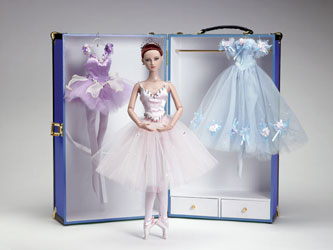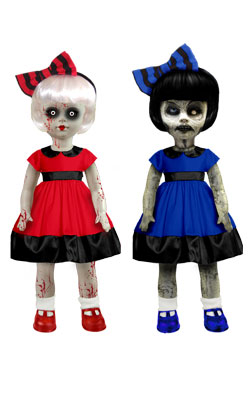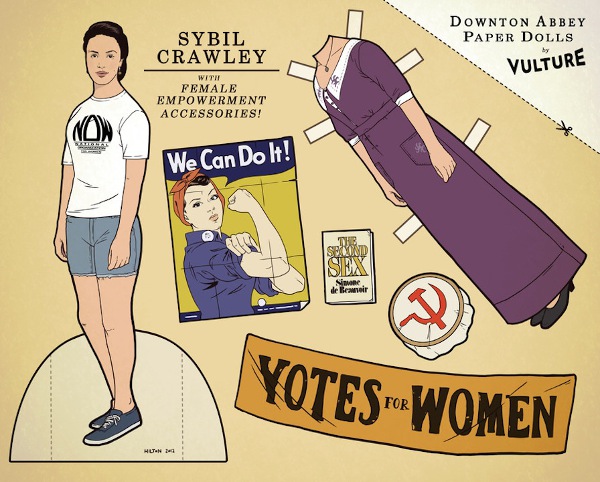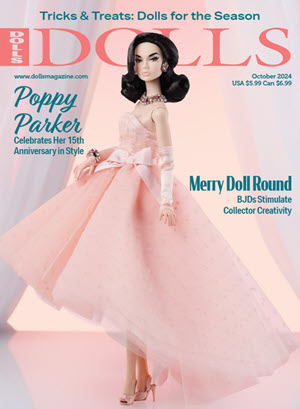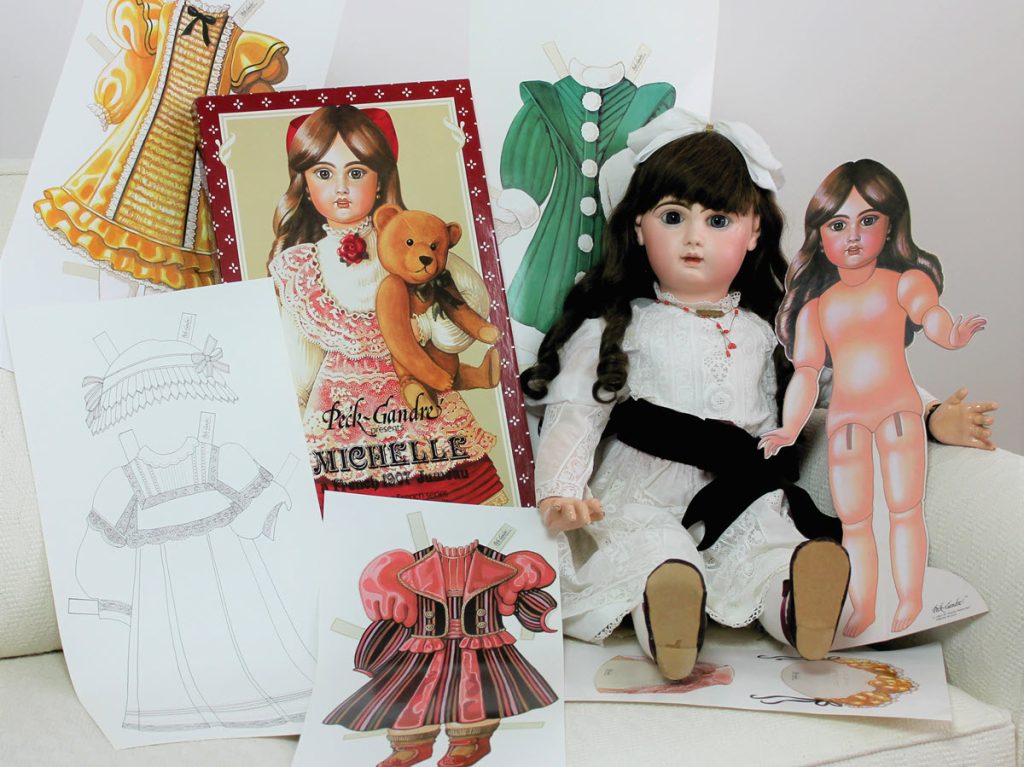
By Karen B. Kurtz
Photos by Mark A. Kurtz
I’ve collected dolls all my life and am still passionate about them today. When I recently shone a bright light on a few paper dolls and researched them against my antique dolls, comparisons, contrasts, and interesting effects interlaced amid names, fashions, and hairstyles. What delightful serendipity across time and space!
Jumeau
The poured bisque socket head on my 29-inch Tête Jumeau, circa 1885 onward, is marked “DEPOSE / TETE JUMEAU / Bte SGDG / 13” and has red artist marks. She has a human-hair wig over a cork pate; large, lustrous paperweight eyes; heavy, feathered brows; accented nostrils and eye corners; a closed mouth; a well-defined chin; and applied ears. Her ball-jointed, wood-and-composition body is marked with a paper sticker: “BEBE JUMEAU / Diplome d’Honneur.” A pull-string “mama-papa” crier, inserted into her torso during manufacturing, still works.
Artists Linda Peck and Marilyn Gandré printed Peck-Gandré Presents Michelle: A French 1907 Jumeau in 1983. My original boxed paper doll set contains a 20-inch paper doll with six colored fashions plus six in black and white for coloring.

Kewpies
Rose O’Neill published some of her Kewpies in Ladies Home Journal in 1909. They were so popular, she asked Joseph Kallus to design a bisque doll. Legend says 30 German factories had a hard time keeping up with the demand.
Distributor George Borgfeldt held on to the design patents after O’Neill’s death. Eventually, he passed the rights to Kallus, who was then president of Cameo Doll Company in Pennsylvania. Kallus licensed Effanbee, Strombecker, Knickerbocker, and Amsco to manufacture Kewpie dolls in composition, plastic, and vinyl to meet an ever-strong demand. Jesco took possession of the Kewpie trademark and copyright in 1984.
The Kewpies: A Paper Doll Book (Saalfield/Artcraft, 1963) has three punch-out paper dolls and six costume pages. Saalfield printed Kewpie-Kin Paper Dolls With Wrap-Around Dressmaker Costumes in 1967. Tom Tierney’s Cupie Paper Dolls in Full Color (Dover, 1984) features two roly-poly paper dolls with red cheeks, topknots, tiny wings, and twinkling eyes. He depicts two-sided paper dolls and imaginative costumes for better viewing.

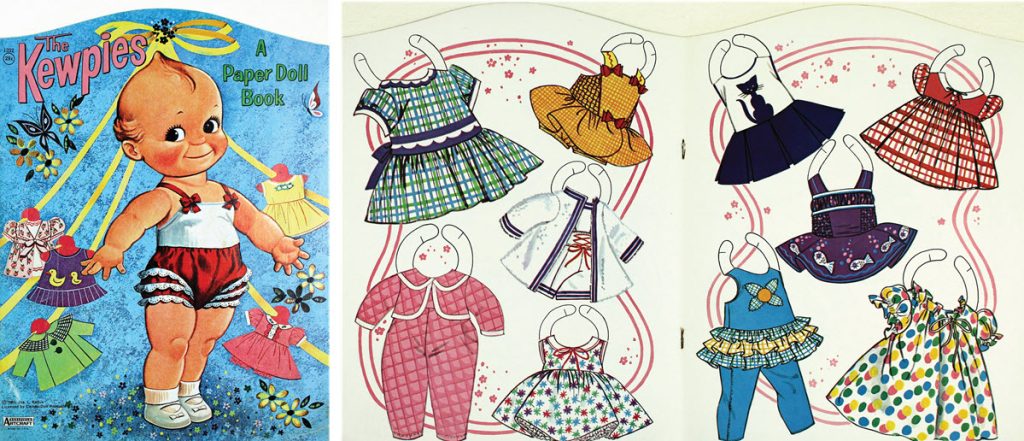
François Gaultier
Peggy Jo Rosamond depicts three new, mint-in-box dolls (Antique French Doll: Paper Dolls, Evergreen Press, 1975), just as they appeared in a stylish Parisian shop long ago. Fancy costumes sprinkle over four pages, and the “Charity Bazaar Doll Stall” provides even more interactive fun. Rosamond rendered a François Gaultier (F.G.) lady with a bisque shoulder plate and a marked Gesland body.
When I stumbled upon an F.G. child in a Louisiana shop, I sucked in air because F.G. children are more elusive than his ladies. The doll had a pale bisque head, large paperweight eyes, long lashes, plump cheeks, pierced ears, and a dusty gray mohair wig. On her French composition body with straight wrists, she wore an original red velvet dress trimmed in black, a black fur-lined stole with matching muff, dainty underclothing, black stockings, and tie shoes with buckles.
I happily paid the dealer and packed her carefully for Indiana, where costumer Elaine Wojcinski cleaned my F.G. child and her clothing, added a cork pate, and washed that pitiful old wig. Miraculously, a cascade of soft blond curls emerged. I named my precocious child Sassy and entered her in competition. Amazingly, Sassy won first place in her category!

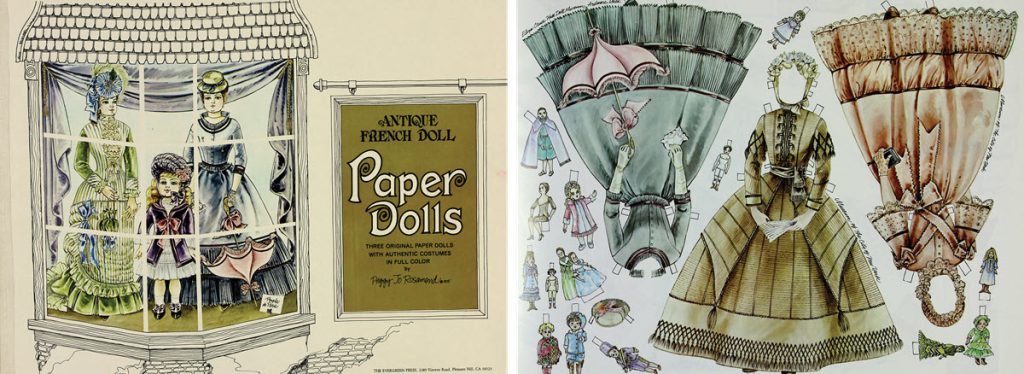
Black China
Antique dolls in Rosamond’s paper doll books seem to glow, and nowhere is this more evident than in Antique Black Doll Paperdolls (Hobby House Press, 1991).
Experts think my Black china doll, circa the 1870s, was manufactured in Germany by the A.W. Fr. Kister Company. She has a porcelain shoulder head, gleaming ebony complexion with realistic features, short hair arranged in tight curls, deeply sculpted eyes with upturned black pupils, pronounced eye whites, and a closed mouth. She is marked “3” on her neck. She came from Virginia in a simple homespun dress.

Brownies

Palmer Cox’s twinkling imagination inspired his Brownie dolls. Growing up in Quebec, he was fascinated by his family’s Scottish folktales. His Brownies are an adventurous, mischievous group of wee folks with their own personalities, nationalities, and occupations. They perform good deeds together and always overcome difficulties with good cheer.
Cox published Brownie stories in the children’s magazine St. Nicholas and Ladies Home Journal. He published books, too, but few Brownie books survive. Paper dolls, cloth dolls, bisque figurines, and other treasures are still found.
He was the first artist to license cartoon characters for advertising and mass merchandising promotions. Children begged for a complete set of Brownie paper dolls that came free in packages from Lion Coffee and New York Biscuit Company.
Arnold Print Works arranged 12 Brownie characters on a yard of fabric and their cloth dolls are well known. Mothers bought them in shops to cut and sew at home. Original Brownies are marked “Copyrighted 1892 by Palmer Cox.” Reprinted dolls often have a faded, washed-out appearance.

My cluster of unmarked cloth Brownies, circa the 1930s to 1950s, adds color and whimsey to a shelf. They are about the same size as the Standing Brownies from Lion Coffee.
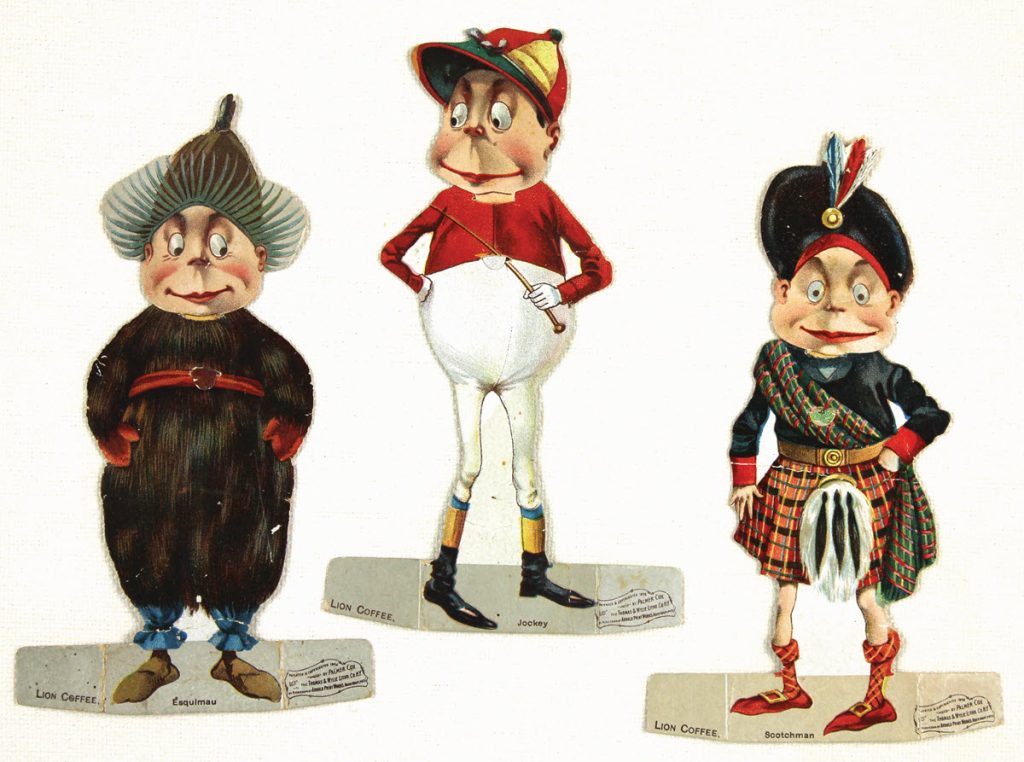
Bun China
Factory owners considered doll heads mere trifles in the time when Germany was the worldwide center of china doll manufacturing. Dozens sat on the kiln shelves alongside expensive figurines and dishware. Dishes were marked, but not the china doll heads.
Manufacturing mysteries persisted until the 1990s, when Mary Gorham Krombholz and other researchers traveled to the old factory sites to study shards buried under attic floorboards and in the dumping grounds. (Access opened after the Berlin Wall fell.)
Krombholz’s book says the prolific Dressel, Kister and Company manufactured my early unmarked bun china lady, circa the 1840s onward. And Inside Porcelain Doll Shoulder Heads by Elizabeth Ann Coleman and Kathy Turner agrees. (This doll company was renamed A.W. Fr. Kister, under the leadership of a second-generation family member, August Wilhelm Friedolin Kister, in 1863.)
My bun china doll has a quality pink-tint china shoulder head with pink-tone china limbs, a muslin body, a cameo-shaped face with serene appearance, an aquiline nose, and a long neck. A molded and painted hairstyle falls from a smooth center part, flows over her ears, and ends in a braided bun at the back.
Bun hairstyles come in many variations, and paper dolls support the look: The Genuine Young Victoria by Brenda Sneathen Mattox, 2017; Queen Victoria by Eileen Rudisill Miller; and 1840s China Head Doll With Articulated Peg-Wooden Body by Roy L. Brindamour, 2005, not shown.

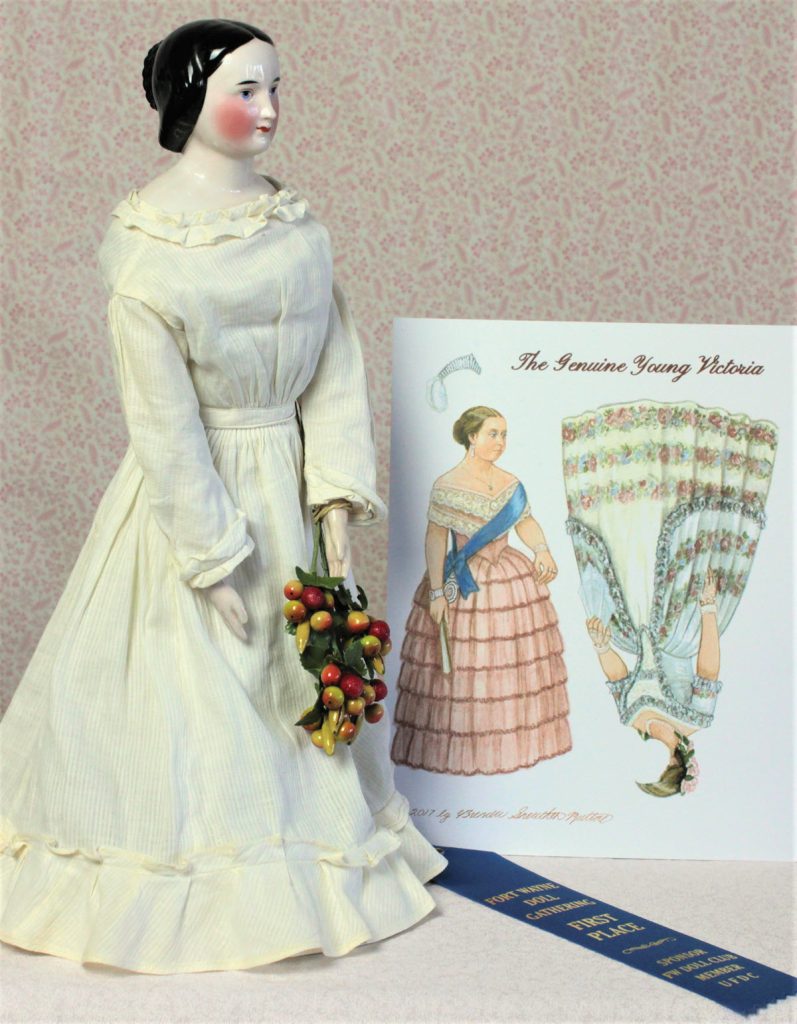
French Mystery Maker
Rosamond’s comprehensive paper doll book Antique Black Doll Paperdolls highlights Black doll manufacturing from early wood and papier-mâché, through china and bisque, to 1930s composition. Historical accuracy coupled with splendid period costumes preserves its importance.
Rosamond’s spread “The Lady of Sudan Goes to Paris” resembles my Black bisque doll from a French mystery maker. My doll has black pupilless eyes and a human-hair wig, but her features are not realistic.
White factory owners used cost-saving measures whenever they could; producing Black dolls with realistic features was time consuming and expensive. These factory owners knew white dolls sold easier than Black dolls, so they created mountains of white dolls. Occasionally, the factory workers — who were often children — painted a few of them black or brown.
Was my doll a tourist souvenir from French Algiers, Morocco, or Tunisia? Back then, women were treated like chattel — sold as concubines or slaves to Black and white men alike.
My original doll’s exotic beaded silk outfit is “laddering.” Rosamond’s “Lady of Sudan” seems ready to step into an elaborate costume. Both may depict cultural transformations.
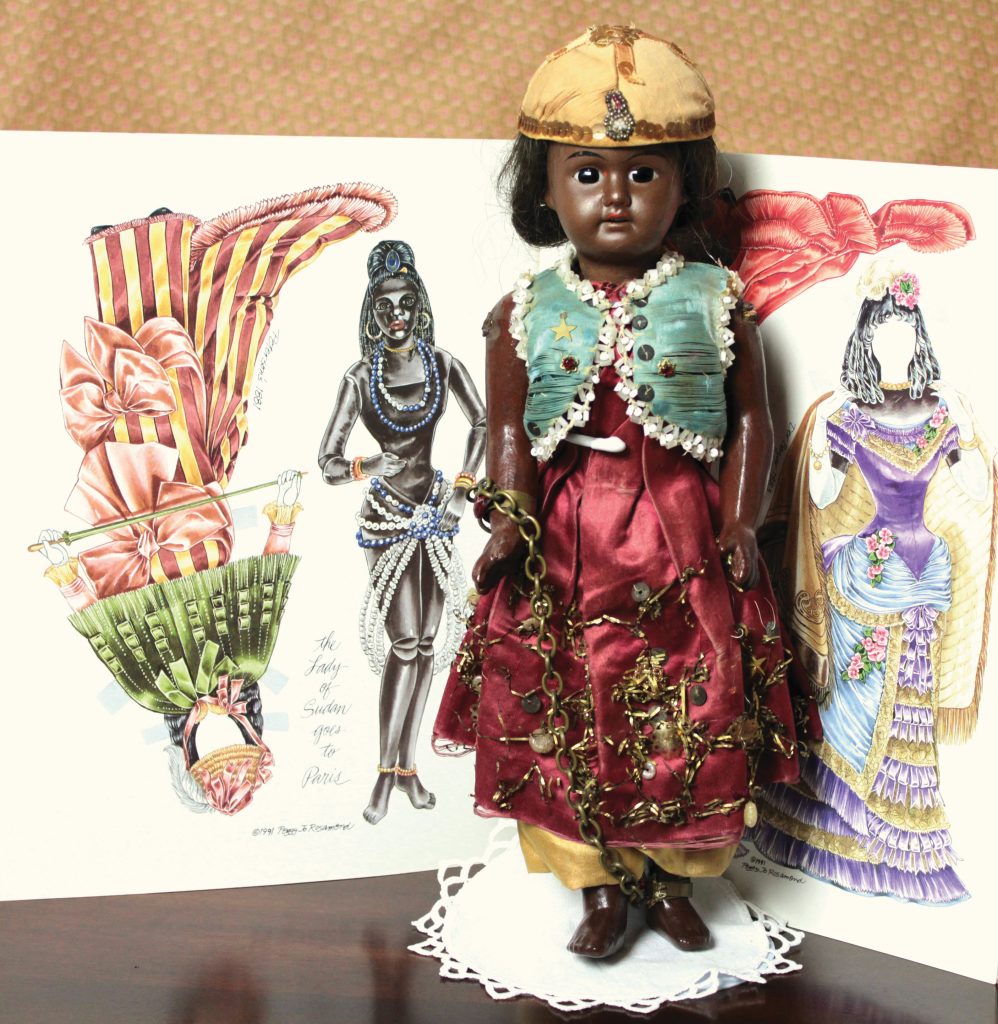
The simple exercise of plaiting a few antique dolls and paper dolls in my collection together, entwining and juxtaposing them, taught me more about their individual beauty than cursory glances in my tubs and cabinets.
Karen B. Kurtz specializes in writing about dolls, history, and antiques. Find out more at karenbkurtz.com and sophiasgiftbook.com.

